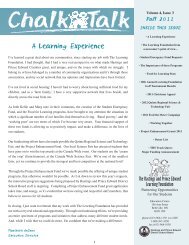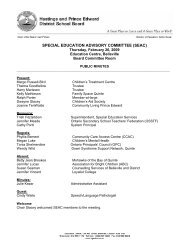Grade 11 Healthy Active Living Education Additional Supports ...
Grade 11 Healthy Active Living Education Additional Supports ...
Grade 11 Healthy Active Living Education Additional Supports ...
Create successful ePaper yourself
Turn your PDF publications into a flip-book with our unique Google optimized e-Paper software.
Positive Mental Health and Stress<br />
Public Profile<br />
Unit #3 Activity #4<br />
Teaching Learning Strategy #4<br />
Teacher Resource (Background Information)<br />
Catholic Profile<br />
Unit #5 Activity #2<br />
Teaching Learning Strategy #3<br />
Definition:<br />
Mental illness is a disturbance in thoughts and emotions that decreases a personÕs<br />
capacity to cope with the challenges of everyday life.<br />
Media are very influential in shaping our impressions and ideas about mental illness. We<br />
are exposed daily to radio, television and newspaper accounts that present people with<br />
mental illness as violent, criminal, dangerous, comical, incompetent and fundamentally<br />
different from other people. These inaccurate images perpetuate unfavourable<br />
stereotypes, which can lead to the rejection, marginalization and neglect of people with<br />
mental illness.<br />
Misconceptions<br />
Commonly held misconceptions of people with mental illness include:<br />
1. People with mental illness are all potentially violent and dangerous.<br />
• most common misconception<br />
• in reality people with mental illness are no more dangerous than people who do not<br />
experience mental illness. (Canadian Mental Health Association, Ontario Division,<br />
2000)<br />
• people with diseases such as schizophrenia are more likely to be violent towards<br />
themselves<br />
2. People with mental illness are somehow responsible for their condition.<br />
• wrongfully characterized as a weakness or character flaw<br />
• occurs all over the world in all races, in all cultures, and in all social classes<br />
• often there are biological, chemical or genetic factors that contribute to the mental<br />
illness<br />
3. People with mental illness have nothing positive to contribute.<br />
• throughout history, people with serious mental health problems have been leaders and<br />
visionaries<br />
• examples in every area: politics, culture, academics, business, athletics, arts and<br />
science<br />
Secondary students are at an age where they are forming opinions and values that will be<br />
with them for life. We need to reduce the stigma associated with mental illness. This is<br />
the time to help students develop a strong sense of understanding, empathy, compassion<br />
and tolerance Ð essential elements in healthy individuals and caring communities.<br />
<strong>Grade</strong> <strong>11</strong> <strong>Healthy</strong> <strong>Active</strong> <strong>Living</strong> <strong>Education</strong> (PPL30), Module #2 Positive Mental Health and Stress<br />
Page 61
















